Back to Basics - Colour
Our Back to Basics series is aimed at people who fall in love with all our beautiful ferrets at shows, rescue centre open days and public relations events but who are, very wisely, taking time to do a bit of research before introducing their own into the family. They often buy Ferrets First to get the feel of the ferret world and we think they deserve a feature of their own. Basics really does mean basics, so knowledgeable readers - look away now!
A ferret's colour would seem to be a very simple matter. Although the chap who said to me: "Ferrets, they're only one colour, aren't they?" was taking that to extremes.
"What colour's that then?" I replied.
There was a pause: "Ferret-coloured," he said.
Many ferret lovers would prefer that no-nonsense approach to the fad of breeding for colour prevelant in the United States and growing in popularity elsewhere.
Those of us with rescue ferrets are used to the 'normal' range of colours - the RSPCA doesn't come across many spotted, striped or polka dot ferrets straying on city building sites. And a look down the list of winners at ferret shows across the country will reveal a clutch of familiar names. Snowy will almost certainly be albino, light silver or black-eyed white; Bandit a polecat, Toffee and Caramel a pair of sandies and Socks a mitt.
At ferret shows, it used to be common for classes to be held for albinos and polecats, with other colourations classed as 'coloured ferrets'. Now it is more likely that classes will be held for albinos, polecats, sandies and silvers, with any other colours (eg: mitts, black-eyed whites) classed as 'coloureds'.
Dr June McNicholas, publicity officer with the National Ferret Welfare Society, told Ferrets First: "Coat colour has little to do with character, personality or working ability. Some working ferreters prefer albino or light-coloured ferrets but this is likely to be only a matter of convenience since they are easier to see against the dark background of rabbit holes and hedgerows.
"On the whole, coat colour is a matter of preference. A healthy ferret will be a lively, fun-loving, and affectionate companion whatever his colour."

ALBINO ferrets have pale coats, ranging from pure white to almost primrose yellow, but they will always have red eyes. As they have no pigment in their eyes, the blood supply shows through. Albinos are just as strong and healthy as any other colour group.
DARK-EYED WHITE ferrets are rarer than albinos. They are pale coated with black, dark blue or brown eyes.
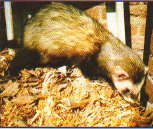
POLECAT ferrets have the same markings as wild polecats. They have a distinctive dark mask across the eyes and dark coloured limbs and tail. The body colour may also be very dark but there can be dark guard hairs over a light undercoat.
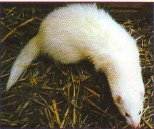
SILVER ferrets are pale coated with darker tips to each hair, giving a silver, frosted appearance. Often with dark eyes, they are striking ferrets and were once sought after for their attractive appearance, although they are now much less rare.
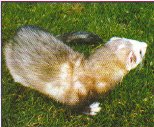
SILVER-MITT ferrets are recognised by their white feet, although they can also have polecat markings. Some have white or yellow bibs or throat flashes. Some may have pale face markings or a blaze like a badger.
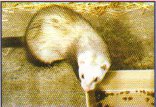
SANDY ferrets range from pale gold to deep red, with a burnt-toffee colour somewhere in between. They sometimes have a polecat-style mask and look like chocolate polecats.
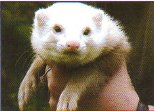
COLOURED ferrets are the ones 'left-over'. Their coats vary from greyish to a rich pinkish fawn with siamese-type darker points.
